The construction industry is under increasing scrutiny regarding its environmental impact, and innovative practices are necessary for sustainable development. One of the most promising advancements in this field is the use of Laminated Veneer Lumber (LVL) formwork. This article explores the various environmental benefits of LVL formwork in construction, highlighting its role in reducing carbon footprints, minimising waste, and promoting sustainability.
Understanding LVL formwork and its role in construction
LVL formwork is a modern construction material made from layers of thin wood veneers that are glued together under heat and pressure. This engineered wood product has gained popularity due to its strength, versatility, and sustainability. The unique structure of LVL allows for greater load-bearing capacities with less material, making it an excellent choice for formwork applications in building projects.
What is LVL formwork?
LVL formwork is a type of temporary structure used to support concrete during its curing process. Unlike traditional timber formwork, which can be inconsistent in quality and often requires extensive processing, LVL formwork is manufactured to precise specifications. This consistency not only improves the overall quality of construction but also enhances the efficiency of the building process. Additionally, the uniformity of LVL reduces the risk of defects that can arise from natural wood, such as warping or splitting, ensuring that the formwork remains stable throughout the curing period.
The process of using LVL formwork in construction
The use of LVL formwork in construction involves several steps. Initially, the LVL panels are cut to the required dimensions, ensuring they fit the specific design of the project. These panels are then assembled on-site to create the necessary moulds for pouring concrete. Once the concrete has set and cured, the LVL formwork can be easily dismantled and reused, further contributing to its environmental credentials. This reusability not only reduces waste but also lowers costs for contractors, as the same formwork can be employed across multiple projects, maximising its utility and lifespan.
Moreover, the lightweight nature of LVL formwork simplifies handling and installation, allowing for quicker assembly times compared to heavier alternatives. This efficiency can significantly accelerate project timelines, enabling construction teams to meet tight deadlines without compromising on quality. Furthermore, the adaptability of LVL makes it suitable for a variety of applications, from residential buildings to large-scale commercial structures, showcasing its versatility in the ever-evolving landscape of modern construction.
The environmental impact of traditional construction methods
Traditional construction materials, such as concrete and steel, have significant environmental drawbacks. The production and use of these materials contribute to substantial carbon emissions and generate considerable amounts of waste, making them less sustainable options in today’s eco-conscious world.
The carbon footprint of conventional construction materials
Concrete production is one of the largest sources of carbon dioxide emissions globally, accounting for nearly 8% of the world’s total. The extraction, processing, and transport of raw materials needed for steel and concrete also contribute significantly to greenhouse gas emissions, resulting in a high carbon footprint throughout the construction process. This concerns both builders and policymakers, as the construction sector seeks greener solutions. Moreover, the energy-intensive nature of these materials means that the entire lifecycle—from quarrying to manufacturing—exerts a heavy toll on the environment. As the demand for urban development continues to rise, the challenge of balancing growth with sustainability becomes ever more critical.
The waste problem in the construction industry
In addition to high carbon emissions, traditional construction methods often result in substantial waste generation. Excess materials, offcuts, and defective components contribute to landfill burdens. In fact, construction and demolition activities are responsible for around 38% of all waste generated in the UK, which presents a pressing need for more sustainable practices. The issue is exacerbated by the lack of effective recycling systems for construction waste, which often ends up in landfills rather than being repurposed. Innovative approaches, such as modular construction and the use of reclaimed materials, are gaining traction as viable alternatives that not only reduce waste but also promote a circular economy. By rethinking how we design and construct buildings, we can significantly mitigate the environmental impact associated with traditional methods and pave the way for a more sustainable future in construction.
How LVL formwork reduces environmental impact
In contrast to traditional materials, LVL formwork offers a sustainable alternative that addresses both carbon footprint and waste production. Its unique properties allow for more efficient building practices, which can lead to a reduced environmental impact in various stages of construction.
The sustainable sourcing of LVL formwork
One of the main advantages of LVL formwork is its sustainable sourcing. LVL is primarily made from fast-growing timber species, which can be harvested in a sustainable manner. Responsible forestry management ensures that the timber is sourced from forests that are managed effectively to maintain ecological balance. This practice helps to reduce deforestation and mitigate habitat destruction while providing a renewable resource for construction.
Furthermore, the use of LVL formwork supports local economies, particularly in regions where timber is a primary resource. By sourcing materials locally, construction projects can stimulate job creation and promote sustainable practices within the community. This not only enhances the economic viability of timber production but also fosters a sense of stewardship towards the environment among local stakeholders, encouraging them to engage in responsible forestry practices.
The energy efficiency of LVL formwork
The energy required to manufacture LVL is considerably less than that needed for concrete and steel production. Moreover, the lightweight nature of LVL means lower transportation costs and emissions. This improved energy efficiency extends throughout the lifecycle of the formwork, making it a more environmentally friendly option in construction projects.
The long-term benefits of using LVL formwork
Beyond the immediate environmental advantages, LVL formwork offers significant long-term benefits that can have profound impacts on both the building industry and the environment. Its durability and reusability are key aspects that contribute to its appeal, making it a smart choice for modern construction.
The durability and longevity of LVL formwork
LVL formwork is known for its strength and durability. Unlike traditional timber formwork or formply that often suffers from warping or degradation after use, LVL can withstand multiple uses without losing structural integrity. This quality means that builders can utilise LVL for numerous projects, reducing the need for frequent replacement and cutting down on waste. Furthermore, the consistent quality of LVL ensures that it performs reliably under various conditions, which is particularly advantageous in regions with fluctuating weather patterns. The inherent resistance of LVL to moisture and pests also contributes to its longevity, making it a more dependable choice for contractors looking to minimise disruptions and maintain project timelines.
LVL formwork and the circular economy
The principles of the circular economy emphasise sustainability and resource efficiency through reuse and recycling. LVL’s ability to be reused multiple times aligns perfectly with these principles, promoting a more sustainable model for the construction industry. After its lifecycle as formwork, LVL can be repurposed for various applications, ensuring minimal waste and maximising resource utilisation. For instance, decommissioned LVL formwork can be transformed into furniture, flooring, or even structural elements in new builds, thereby extending its life cycle and reducing the demand for virgin materials. This approach not only conserves resources but also encourages innovation in design and construction practices, as architects and builders explore new ways to incorporate reclaimed materials into their projects.
Overcoming challenges in implementing LVL formwork
While the benefits of LVL formwork are considerable, several challenges must be addressed to facilitate its wider adoption in the construction sector. Misconceptions and economic considerations play significant roles in limiting its use.
Addressing misconceptions about LVL formwork
There are lingering misconceptions about LVL formwork that can hinder its acceptance. Some industry professionals may believe that LVL does not offer the same performance level as traditional materials, creating hesitation in its adoption. Increasing awareness of its strengths, such as its superior load-bearing capacity and reliability, is essential in changing perceptions and demonstrating its value in construction.
The cost and availability of LVL formwork
The initial cost of LVL formwork timber can be higher than that of conventional materials, which may deter some builders. However, it’s crucial to consider the long-term savings associated with its durability, reusability, and reduced waste. As demand for sustainable construction materials grows, the manufacturing and availability of LVL are expected to improve, resulting in more competitive pricing.
In conclusion, LVL formwork presents a multitude of environmental benefits that align with the construction industry’s shift towards sustainability. By reducing carbon footprints, minimising waste, and promoting the circular economy, LVL formwork is not just a practical choice for modern construction but also a crucial step towards a more sustainable future.


